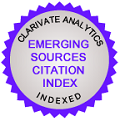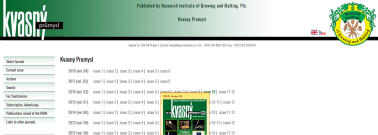Use of common carp waste for pigment production by Monascus purpureus
DOI:
https://doi.org/10.18832/kp2023.69.686Keywords:
Monascus purpureus, pigments, common carp, waste substrate, scales, cultivationAbstract
Fish processing worldwide generates a large amount of waste that has no further use. In this work, we tested the possible biotechnological use of two waste materials from common carp – waste scales and residues from filleting process. Both sources were subjected to alkaline hydrolysis and subsequently used as a source of nitrogen, phosphorus and other elements for the cultivation of the fungus Monascus purpureus, which is known for the production of pigments with potential in pharmaceutics and other sectors of industry. After 14 day-long cultivation of Monascus purpureus in a medium containing hydrolysate as the sole source of all nutrients except carbon, the extraction of pigments and their further analysis were carried out. It was shown that a simple as well as inexpensive alkaline hydrolysis can be used to prepare a complex culture medium suitable for pigment production using fish waste. Moreover, there is a big potential that this medium would also be suitable for many more biotechnological applications.
References
Ajdari, Z., Ebrahimpour, A., Abdul Manan, M., Hamid, M., Mohamad, R., Ariff, A.B. (2011). Nutritional requirements for the improvement of growth and sporulation of several strains of Monascus purpureus on solid state cultivation. Journal of Biomedicine and Biotechnology, 2011, 487329. https://doi.org/10.1155/2011/487329
Blanc, P.J., Laussac, J.P., Le Bars, J., Le Bars, P., Loret, M.O., Pareilleux, A., Prome, D., Prome, J.C., Santerre, A.L., Goma, G. (1995). Characterization of monascidin A from Monascus as citrinin. International Journal of Food Microbiology, 27(2-3), 201–213. https://doi.org/10.1016/0168-1605(94)00167-5
Branská, B., Fořtová, M., Dvořáková, M., Liu, H., Patáková, P., Zhang, J., Melzoch, M. (2020). Chicken feather and wheat straw hydrolysate for direct utilization in biobutanol production. Renewable Energy, 145, 1941–1948. https://doi.org/10.1016/j.renene.2019.07.094
Broder, C.U., Koehler, P.E. (2006). Pigments produced by Monascus purpureus with regard to quality and quantity. Journal of Food Science, 45(3): 567–569. https://doi.org/10.1111/j.1365-2621.1980.tb04102.x
Camesasca, L., Ramírez, M.B., Guigou, M., Ferrari, M.D., Lareo, C. (2015). Evaluation of dilute acid and alkaline pretreatments, enzymatic hydrolysis and fermentation of napiergrass for fuel ethanol production. Biomass & Bioenergy, 74(6), 193–201. https://doi.org/10.1016/j.biombioe.2015.01.017
Carels, M., Shepherd, D. (1977).The effect of different nitrogen sources on pigment production and sporulation of Monascus species in submerged, shaken culture. Canadian Journal of Microbiology, 23(10), 1360–1372. https://doi.org/10.1139/m77-205
Feng, Y., Shao, Y., Chen, F. (2012). Monascus pigments. Applied Microbiology and Biotechnology, 96(6), 1421–1440. https://doi.org/10.1007/s00253-012-4504-3
Han, L., Feng, J., Zhang, Z., Ma, Z., Wang, Y., Zhang, X. (2012). Alkali pretreated of wheat straw and its enzymatic hydrolysis. Brazilian Journal of Microbiology, 43(1), 53–61.
He, J., Jia, M., Li, W., Deng, J., Ren, J., Luo, F., Bai, J., Liu, J. (2021). Toward improvements for enhancement the productivity and color value of Monascus pigments: a critical review with recent updates. Critical Reviews in Food Science and Nutrition, 62(10), 1–15. https://doi-org.ezproxy.techlib.cz/10.1080/10408398.2021.1935443
Husáková, M., Plechatá, M., Branská, B., Patáková, P. (2021). Effect of a Monascus sp. red yeast rice extract on germination of bacterial spores. Frontiers in Microbiology, 12, 686100. https://doi.org/10.3389/fmicb.2021.686100
Kang, B., Zhang, X., Wu, Z., Wang, Z., Park, S. (2014). Production of citrinin-free Monascus pigments by submerged culture at low pH. Enzyme and Microbial Technology, 55, 50-57. https://doi.org/10.1016/j.enzmictec.2013.12.007
Liu, L., Zhao, J., Huang, Y., Xin, Q., Wang, Z. (2018). Diversifying of chemical structure of native Monascus pigments. Frontiers in Microbiology, 21(9), 3143. https://doi.org/10.3389/fmicb.2018.03143
Patáková, P. (2013). Monascus secondary metabolites: production and biological aktivity. Journal of Industrial Microbiology and Biotechnology, 40(2), 169–181. https://doi.org/10.1007/s10295-012-1216-8
Patakova, P., Branska, B., Patrovsky, M. (2015). Monascus Secondary Metabolites. In: Merillon, JM., Ramawat, K. (eds) Fungal Metabolites. Reference Series in Phytochemistry. Springer, Cham. https://doi.org/10.1007/978-3-319-19456-1_15-1
Patrovský, M., Šinovská, K., Branská, B., Patáková, P. (2019). Effect of initial pH, different nitrogen sources, and cultivation time on the production of yellow or orange Monascus purpureus pigments and the mycotoxin citrinin. Food Science and Nutrition., 7(11), 3494–3500. https://doi.org/10.1002/fsn3.1197
Pattangul, P., Pinthong, R., Phianmongkhol, A. (2007). Review of Angkak production (Monascus purpureus). Chiang Mai Journal of Science, 34(3), 319–328. Retrieved from: https://www.thaiscience.info/journals/Article/CMJS/10905732.pdf
Stiborová, H., Branská, B., Veselá, T., Lovecká, P., Stránská, M., Hajšlová, J., Jírů, M., Patáková, P., Demnerová, K. (2016). Transformation of raw feather waste into digestible peptides and amino acids. Journal of Chemical Technology and Biotechnology, 91(6), 1629–1637. https://doi.org/10.1002/jctb.4912
Wu, C.L., Kuo, Y.H., Lee, C.L., Hsu, Y.W., Pan, T.M. (2011). Synchronous high performance liquid chromatography with a photodiode array detector and mass spectrometry for the determination of citrinin, monascin, ankaflavin, and the lactone and acid forms of monacolin K in red mold rice. Journal of AOAC International, 94(1), 179–190.
Yang, M., Yu, Y., Zhai, H., Sheng, J., Xing, T., Chen, G. (2018). Ecological dyeing of silk fabric with Monascus. Journal of the Textile Institute, 109(10), 1329–1334. https://doi.org/10.1080/00405000.2018.1423932
Zhang, Y., Tu, D., Shen, Q., Dai, Z. (2019). Fish scale valorization by hydrothermal pretreatment followed by enzymatic hydrolysis for gelatin hydrolysate production. Molecules, 24(16), 2998. https://doi.org/10.3390/molecules24162998
Zhu, B., Qi, F., Wu, J., Yin, G., Hua, J., Zhang, Q., Qin, L. (2019). Red yeast rice: a systematic review of the traditional uses, chemistry, pharmacology, and quality control of an important Chinese folk medicine. Frontiers in Pharmacology, 10, 1449. https://doi.org/10.3389/fphar.2019.01449

Downloads
Published
How to Cite
Issue
Section
License
Copyright (c) 2023 Jan Kolek, Marek Driml, Matěj Kumžák, Pavel Soukup, Frank Szendzielarz, Matěj Šimera, Barbora Branská, Petra Patáková

This work is licensed under a Creative Commons Attribution 4.0 International License.







